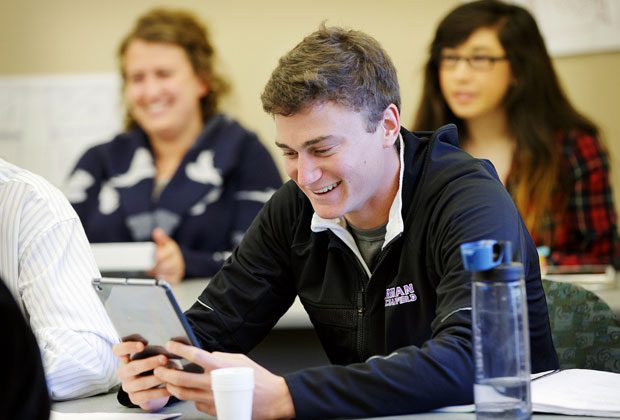Project iPad

When Jeanine Stratton was selected to study the use of iPad minis in the classroom, she was prepared for two possible outcomes – 1) a mountain of data on student hardware and software preferences or 2) the discovery of another way to distract students in her Marketing Principles class. She is happy to report her study didn’t devolve to the latter.
It all started with Jane Love, director of the Center for Teaching and Learning, who secured twenty-five iPads for faculty members. Informally dubbed the “iPad Initiative Group” they accepted the charge to experiment with the tablets for personal research, productivity, and teaching. Said Love, “One thing we heard over and over from faculty was, ‘This is all very nice, but until we get iPads in the hands of students, we can’t even scratch the surface of what we can do with this technology.’” So when the iPad mini entered the tablet fray with a lower price point, Love purchased a class set. She just needed to tap a class to lead the iPad Pilot Study.
Love asked the iPad Initiative Group for proposals on how they would use a class set of minis, and it was Professor Jeanine Stratton’s plan that stood out. “Typically, studies for iPads in education compare metrics like exam scores across similar classes. But Jeanine is going beyond this approach—she’s trying to get a window into students’ learning processes,” said CTL associate director Mike Winiski.
Stratton asked students to produce two “reverse storyboards” for a video-based Public Service Announcement (PSA) project. One of the storyboards had to be crafted with the iPad mini and apps of choice, and the other storyboard (using the same PSA) was to be put together using MS PowerPoint on a PC.
In a counterbalanced model designed to mitigate any “order” effects, half of Stratton’s class first compiled graphics and annotations for the clip on the mini; and the other half used a computer running PowerPoint. Then, for the second iteration, the groups used the alternate platform.
Having the reverse storyboard experience under their belts, students were primed to tackle the next assignment, Stratton’s “PSA Portfolio Project,” where class members would produce their own PSA video and develop their own storyboard using whatever platform they desired. “I’m using choice as a behavioral measure,” said Stratton. Going further, Stratton collected data (ease of use, application preference, etc.) through a focus group and in-class surveys.
While data are still being analyzed, preliminary findings suggest the bulk of students support the use iPads in the classroom. The data shows that seventy-two percent of Stratton’s students consistently chose to use the iPad over PowerPoint for their storyboard drafts; and eighty-three percent agreed storyboarding using the iPads (e.g., with apps such as Penultimate) facilitated the process of planning the video project.
Communication studies major Madilene Lake ’14 says the iPad mini was her hands-down favorite platform for the PSA project. Apps for storyboarding, iMovie, and the touch-screen interface on the mini made filming the video “incredibly easy,” she says.
Economics major and self-proclaimed video editing novice James Perez ’14 says the mini made the project “manageable and enjoyable.” He says, “Being able to research topics, create my storyboard, film my video, and then edit my video was awesome.”
Seth Saler ’14 (political science) agrees, “Everything you’d want to do for a lower-end film could be done from the device and didn’t require the technical skill you might need for other video tools.”
Saler, who had reservations about storyboarding on the mini versus PowerPoint, says he believes the end product was better with the mini. “Being able to draw the storyboard on a touch-screen surface, annotate and make changes on the mini made the editing experience more creative,” he says.
Aside from projects, the iPad mini’s accessibility and portability benefits appeared to generate the most enthusiasm. Says Lake, “The iPad mini made school more mobile … everything is in one place—notes, textbooks, readings, web access, email.”
While convenience, storyboarding, and movie-making capabilities received high marks, note taking on the mini tallied mixed reviews among the three. Lake initially found note taking cumbersome (like typing on a big iPhone), but it became second nature as she honed her skills using the mini in other classes. Accustomed to drawing diagrams and charts by hand, she quickly learned to snap pictures of graphics for popping into notes. Perez, on the other hand, stood by the traditional pen and paper method over keyboarding or writing with a stylus.
Saler found data input on the mini “annoying.” But, at the same time, he says the mini opened a whole new dimension in note taking with the ability to use bullet points, subcategories, and a range of fonts. He says, “The mini forced me to make my notes more concise because input was not as easy as a laptop …”
The data are consistent with students’ note-taking comments. Roughly half agreed the iPad was preferable to taking and managing notes on paper. Stratton believes the addition of peripherals, like an external keyboard and quality stylus would help alleviate some of the input headaches.
With the iPad Pilot in her rearview mirror and data in hand, Stratton is looking forward to getting a better handle on the tablet’s classroom impact. One thing she is sure about—“I learned that all I needed to do was get students set up on the basics, then step out of the way so they could explore!” she says.
And explore they did. Stratton witnessed a remarkable level of peer learning and cooperation as students stretched to find the shortest distance from point A to point B using the mini. She says, “I saw an amplified sense of community in the learning process.”
Stratton and co-authors Winiski and CTL associate director Diane Boyd will present the iPad study findings in a paper later this summer.